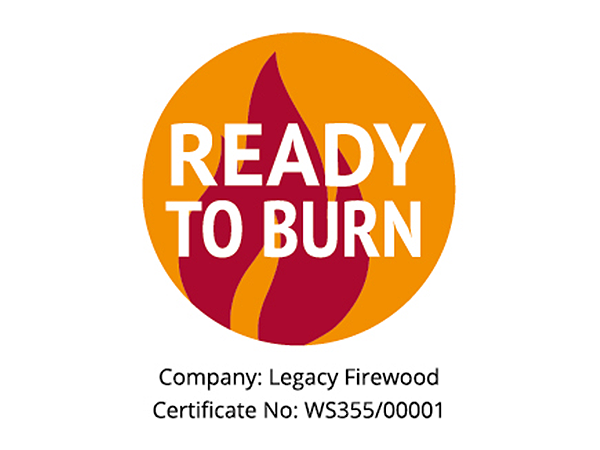Different Types of Wood for Burning and their Characteristics
We would recommend burning one of the many hardwoods that are available in the UK on a wood burner or open fire. Hardwoods are generally more dense than softwood and therefore burn for longer and produce more heat. Hardwoods are also less resinous than softwoods and are therefore less likely to result in a build up of tar deposits in your flue, reducing its efficiency or increasing the risk of a flue fire.
Despite providing a more efficient fuel source, hardwood can be difficult to ignite from cold. Softwood kindling is therefore best used to get a fire started, the resinous and fibrous nature of softwood helping it to burn from cold. Once a fire is established and there is some heat in the base of the fire, it should be fuelled with hardwood to maintain a slow burning fire with a good heat output.
Softwood can produce a very pleasing flame to look at but it will burn very quickly and you will get through a large volume of wood in a very short time.
All wood should be well seasoned before burning. Different woods have different initial water content, often determined by where a tree grows. Willow, for example, likes to grow in wet soils or besides water bodies, therefore the wood from this tree has a high water content and requires longer seasoning. Firewood should have a moisture content of below 30% at least for burning. The density of the wood also affects how long it needs to be seasoned for. Oak is a very dense wood and can take up to 2 years to season fully.
The following is a list of common firewoods with a brief description of their burning characteristics.
| Common Name | Hardwood/ Softwood | Comments | Grade |
Alder |
H |
Opinions vary but it is generally considered as a poor firewood. It burns quickly and gives off little heat. |
Poor |
Apple |
H |
Needs to be seasoned well. Burns slowly with a good heat output and produces a pleasant smell with little sparking or spitting. |
Good |
Ash |
H |
One of the best firewoods and has a low moisture content when green. It can be burned green but like all wood is best when seasoned. Gives a good heat output, good flame and burns slowly. |
High |
Beech |
H |
Beech has a high water content and needs a long seasoning period. Burns well but has a tendency to spark. |
Good |
Birch |
H |
Birch burns easily and can be burnt unseasoned. It also burns very quickly so is often best mixed with a slower burning wood such as Oak or Elm. Birch bark can make an excellent fire-lighter. |
Good-High |
Blackthorn |
H |
Another good firewood, burns slowly, good heat output and little smoke. |
Good |
Cedar |
S |
A good firewood which burns well with a pleasant smell. Gives off a good, lasting heat but little flame. Doesn't spit too much and small pieces can be burned unseasoned |
Low |
Cherry |
H |
Needs to be seasoned well. Burns well with a pleasant smell and without spitting. |
Low-Good |
Douglas Fir |
S |
Not a very good firewood, produces little flame or heat. |
Poor |
Elder |
H |
Burns quickly with little heat output. Produces lots of smoke |
Poor |
Elm |
H |
A good firewood but due to its high water content it must be seasoned very well. It may need assistance from another faster burning wood such as Birch to keep it burning well. However it gives off a good, lasting heat and burns very slowly. |
Low-Good |
Hawthorn |
H |
Good firewood. Burns well with good heat output and little smoke. Hawthorn can be difficult to split as straight lengths are rare. |
Good-High |
Hazel |
H |
Excellent firewood. Burns quickly without spitting |
High |
Holly |
H |
Can be burnt green. A good firewood |
Good |
Hornbeam |
H |
Good firewood. Burns well |
Good |
Horse Chestnut |
H |
A low quality firewood, spits a lot. |
Low |
Larch |
S |
Needs to be seasoned well. Spits excessively while it burns and can produce a lot of soot deposits that can line the flue, firebox and glass window of your stove. |
Poor |
Lime |
H |
A low quality firewood |
Low |
Oak |
H |
One of the best firewoods but needs a long seasoning period due to its density. Burns slowly and is long lasting. On smaller stoves it is best burnt in smaller pieces than other woods. |
High |
Pear |
H |
Needs to be seasoned well. Burns well with a pleasant smell and without spitting. |
Good |
Pine |
S |
Burns well but tends to spit and can leave sooty deposits. The resinous wood makes good kindling |
Low |
Plane |
H |
A usable firewood |
Good |
Poplar |
S |
Burns slowly to produce a black choking smoke even when seasoned. |
Poor |
Rowan |
H |
Good firewood. Burns well |
Good |
Spruce |
S |
A low quality firewood |
Low |
Sweet Chestnut |
H |
Burns when seasoned but spits continuously and excessively. If burning on an open fire, be wary of flying sparks. |
Poor-Low |
Sycamore |
H |
Good firewood. Burns well but only produces a moderate heat output. |
Good |
Walnut |
H |
A low quality firewood |
Low |
Willow |
H |
Willow has a high water content so only burns well when very well seasoned. |
Low |
Yew |
H |
A usable firewood |
Low-Good |


